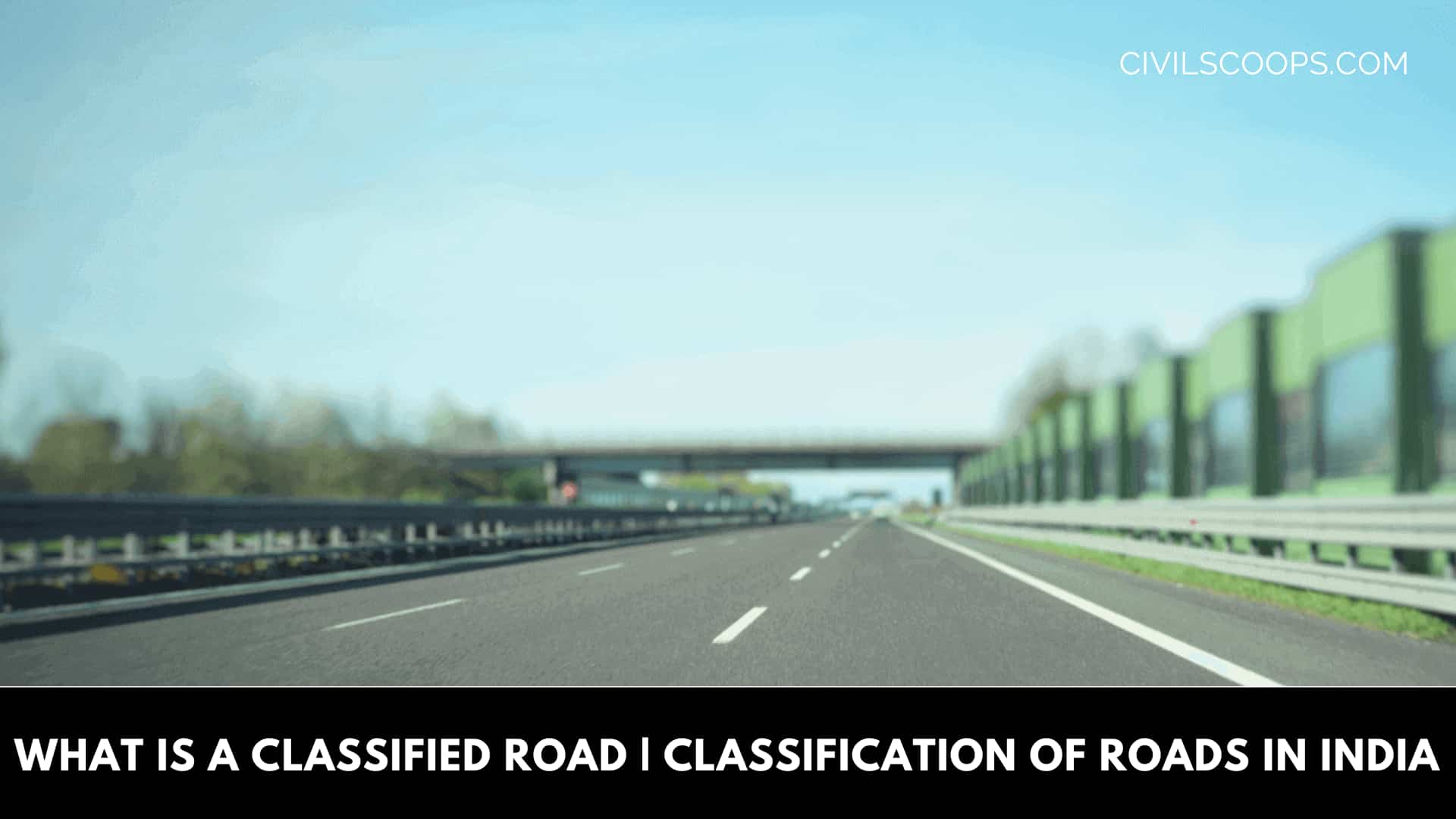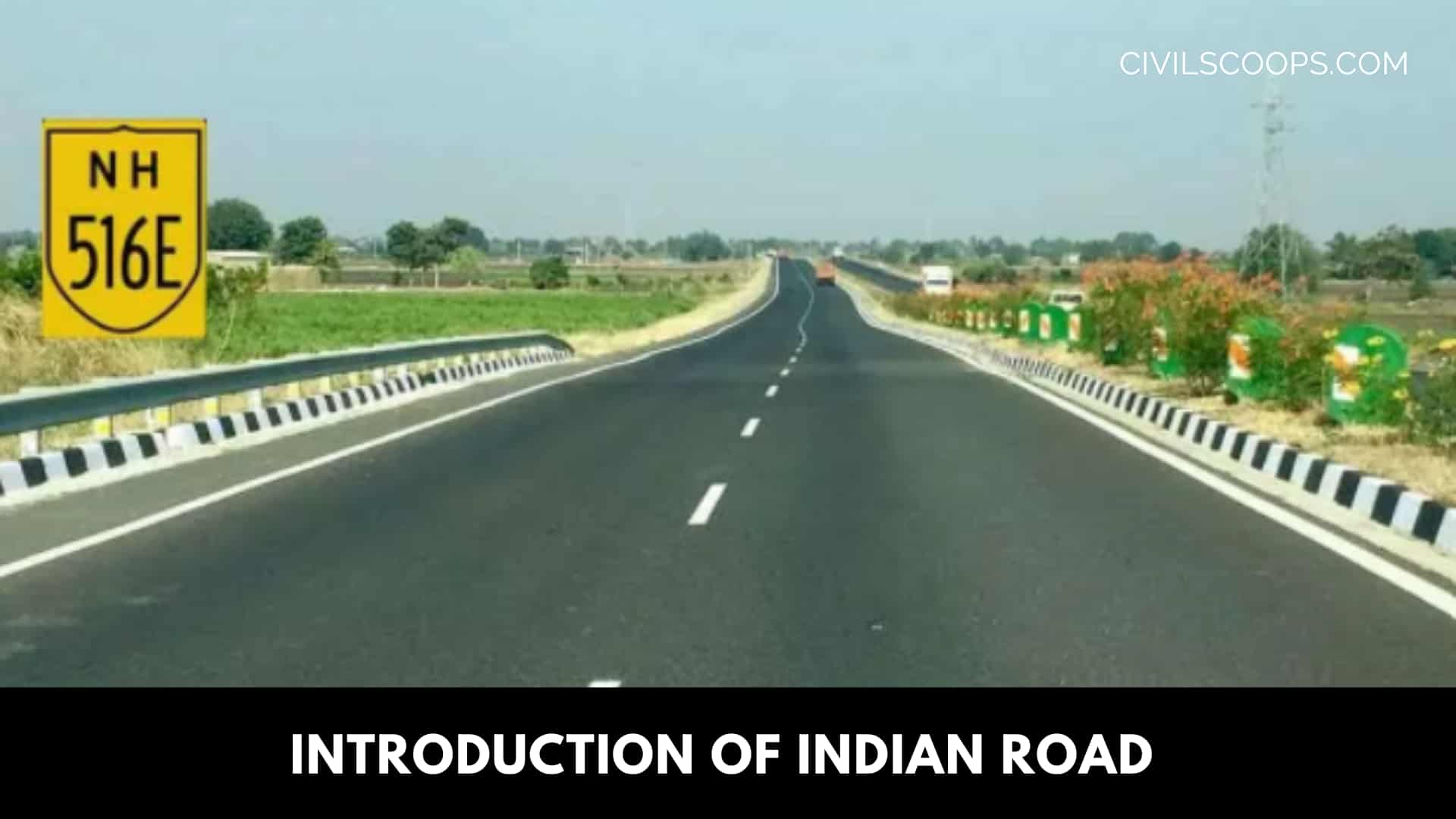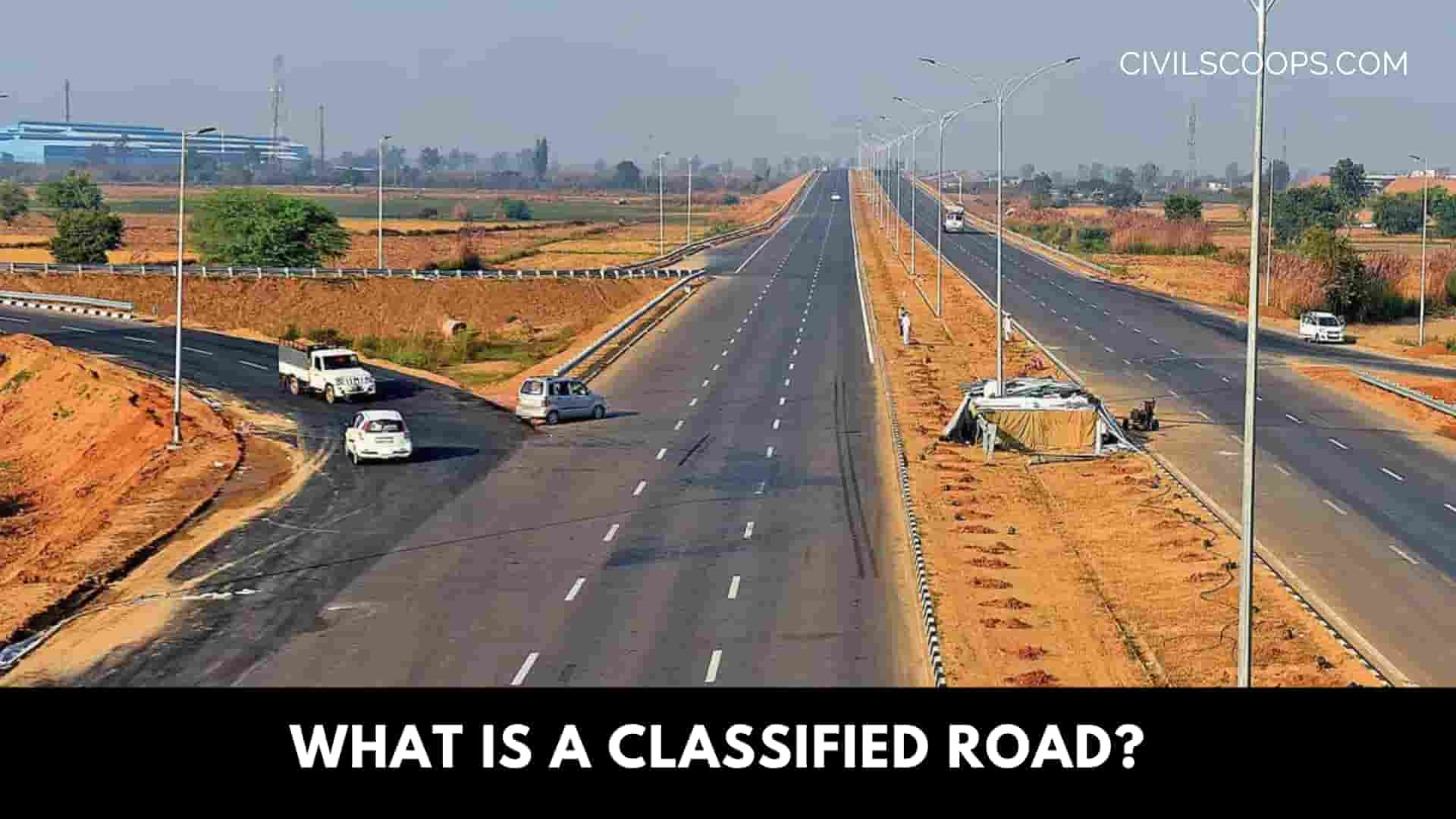What Is a Classified Road | Classification of Roads in India

Table of Contents
Introduction of Indian Road

- India is a very vast country and where the economic development of the country mainly depends upon its Transportation.
- The road is one of the most important modes of transport in India. Road plays a very crucial role in the overall development of the country.
- The Road network of India is one of the biggest and second-largest road networks all over the world.
- In this article, you will get to know about the Classification of roads in India and the types of roads in India.
Classification of Roads in India
- The roads are classified into different types in India. The roads are mainly classified based on the different areas in the country. The classification of roads in India is as follows.
- For the overall development of the different areas of any Nation, there must be an efficient and planned network of roads that connect Different cities, towns, and villages all over the country.
- Urban roads play a vital role in the development of the town. The Efficiency of the urban area is affected by the Urban road.
What Is a Classified Road?
A Classified road consists of a highway or proposed highway which is a classified road by section 12 of the HA 1980.

Classification of the roads is done on the following factors
According to the Traffic
According to the Transported Tonnage
According to the importance
According to the location and function of the roads
According to the materials used in the construction of the roads
According to the Traffic
Based on the total traffic volume the roads are classified as
[su_table responsive=”yes” alternate=”no”]
| Sr.No. | Types of Road | Vehicles per Day |
| 1 | Very heavy traffic roads | Above 600 |
| 2 | Heavy traffic roads | 251 to 600 |
| 3 | Medium traffic roads | 70 to 250 |
| 4 | Light Traffic roads | Below 70 |
[/su_table]
According to the Transported Tonnage
Based on total tonnage for a day the roads are classified as follows
[su_table responsive=”yes” alternate=”no”]
| Sr.No. | Types of Road | Vehicles per Day |
| 1 | Very heavy traffic roads | Above 1524 |
| 2 | Heavy traffic roads | 1017 to 1524 |
| 3 | Medium traffic roads | 508 to 1017 |
| 4 | Light Traffic roads | Below 508 |
[/su_table]
According to the Importance of the Road
According to the importance of connecting holy places and stations of strategic importance, roads are classified as follows
- Class 1 Roads
- Class 2 Roads
- Class 3 Roads
According to the Location and the Function of the Road
Classification of the road is also based on the location and function of the road
Types of Roads as Per Location and Foundation
- Expressways
- National highways(NH)
- State Highways(SH)
- District Roads
- Major District Roads(MDR)
- Other District Roads(ODR)
- Village Roads (RR)
1. Expressways

- Expressways are roads that have more than four lanes. Expressways allow high-speed vehicles.
- The Construction and Maintenance work of the Expressway are operated by the Ministry of Road Transport and Highways (MORTH).
- The first expressway in India is the Delhi-Noida Direct flyway which is an Expressway that connects Delhi and Noida with each other.
- Mumbai-Nagpur Expressway becomes one of the largest expressways in India.
Also Read: Top 10 Companies for Environmental Engineers to Work For
2. National Highways (Nh)

- National highways are the Highways that connect the major cities in India. The National Highways also connect the state capitals.
- National highways generally have a width ranging from 7 m to 15 m which connects the capital cities of various states all over the country.
- National highways play and very important role to link the network for the transportation of men and materials.
- National highways can carry fast and heavy traffic.
- The National highways in India are further classified on the width of the carriageway of the Highways.
- The Construction, Maintenance, and Management of the national highways are done by the National Highways Authority of India (NHAI).
- One of the major and largest ongoing highway development projects in India is the Golden Quadrilateral and the north-south and east-west corridor.
Also Read: Steel Is Most Trusted TMT Bar in India?
Example of National Highways in India
- Delhi-Agra-Kanpur-Kolkata road-NH2
- Agra-Mumbai Road-NH3
- Amritsar-Ambala-Delhi road-NH1
3. State Highways

- State Highways are the Highways that mainly connect the major cities throughout the state.
- State highways are roads that have widths ranging from 7 m to 10 m and connect the national highways and the district places all over the state.
- State Highways can carry medium to fast traffic. State Highways and National highways have the same design speed and design specifications for road construction.
- State governments have the authority and responsibility to construct and maintain the state highway. Many state highways had been constructed by the state Public Works Department.
- Public Works Department has the responsibility to construct and maintained the road.
- In India, Maharashtra has the largest share of state highways in the country.
4. District Roads

- District roads are the roads that connect each district place to the Taluka place.
- The width of the district roads generally ranges from 5 m to 8 m.
- The design speed of the vehicles on the district roads is very less as compared to the design speed on the highways. District roads are generally carrying moderate traffic.
- The Zilla Parishad has the Authority and responsibility to construct and maintain the district roads. The state government gives grants for the development of the district roads
- District road also connects with state Highways and national highways.
- The District roads are classified into two categories which are Major district roads and Other district roads. Other District Roads also connect with the City Roads.
5. Village Roads

- The roads which connect any village to the district roads are known as village roads.
- The village roads are kaccha roads or earthen roads which only carry light traffic. It connects to the various City Roads.
- Village road mainly connects the villages or groups of villages with each other with the nearest road of a higher category.
- Village roads play and very important role in the development of rural areas.
- Village roads are generally on method with a single Lane width of stabilized soil or gravel. The responsibility for the construction and maintenance of rural roads lies with the local district Authorities.
According to the Materials Used
Types of Roads as Per Materials
- Earthen roads
- Water macadam roads(W.B.M)
- Cement Concrete Roads
- Bituminous roads
1. Earthen Roads

- Art and roads are generally constructed with earth materials. These are the kaccha road in which Earth is one of the main constituents.
- Earthen roads are generally constructed in the ruler areas and are also known as village roads.
2. Water Macadam Roads (W.b.m)

- Water-bound macadam roads consist of broken pieces of stones of varying sizes ranging from 25 mm to 75 mm and are laid in three layers on the subgrade.
- The bigger size pieces of the stones are laid in the bottom course of the road.
- This type of role is also usually provided in rural areas as village roads.
- Water Bound Macadam roads are the compact base for the vitamin is a road and the concrete roads.
Cement Concrete Road

- A cement concrete road is a rigid pavement that consists of a rigid wearing surface on the top surface of the road.
- The lifespan of the concrete road is greater and more durable as compared to Bituminous Roads.
- The repair and maintenance work of the cement concrete road is very difficult due to the rigidity of the concrete.
Bituminous Roads

- In the construction of the Bituminous Road, the final finished surface is Bitumen.
- It is a flexible pavement in which first the water-bound macadam surface is prepared. On these roads, Bitumen acts as a Binder.
- This type of road gives a smooth wearing surface at the top of the road.
According to the Third Road Development Plan
According to the Third Road Development Plan the Roads Are Classified as Follows
Types of Road as Per Third Road Development Plan
Primary System
- Expressways
- National Highways(NH)
Secondary System
- State Highways(SH)
- Major District Roads(MDR)
Tertiary System
- Other District Roads(ODR)
- Village Roads(VR)
[su_box title=”FAQ” style=”default” box_color=”#333333″ title_color=”#FFFFFF” radius=”3″ class=”” id=””]
What Is a Road?
A wide way leading from one place to another, especially one with a specially prepared surface that vehicles can use.
What Are Roads Made Of?
Most of our roadways and streets are paved with asphalt concrete. Asphalt concrete is a simple product in appearance produced primarily by adding asphalt cement to sand and rock
What Is a Classified Road?
Classified road means a road or work declared under part 5 of the roads act 1993 to be a main road, a secondary road, a state highway, a tourist road, a state work, a freeway, a tollway, or a controlled access road within the meaning of that act; sample 1sample 2.
Types of Roads
- Dirt roads
- Rural roads
- Metropolitan roadways
- Suburban roads
- State highways
- Interstate highway system
- Toll roads
Types of Highways
Highways in the United States are split into at least four different types of systems: Interstate Highways, U.S. Highways, state highways, and county highways.
Types of Road Construction
These types of road construction include earthen roads, gravel roads, concrete roads, asphalt roads, composite roads, recycled roads, and bituminous roads.
Types of Road Pavement
- Porous Asphalt
- Perpetual Pavement
- Quiet Pavement
- Warm-Mix Asphalt
- Thin Overlays
3 Types of Road Signs
Types of road signs are divided into three basic categories: regulatory, warning, and guide signs.
4 Types of Road Signs
Diamond-shaped signs signify warnings. Rectangular signs with a longer direction horizontal provide guidance information. Pentagons indicate school zones. A circular sign warns of a railroad crossing.
Classification of Roads
Functional classification is the process by which public streets and highways are grouped into classes according to the character of the service they are intended to provide. Generally, highways fall into one of four broad categories: principal arterials, minor arterials, collector roads, and local roads.
Classification of Highways
Generally, highways fall into one of four broad categories: principal arterials, minor arterials, collector roads, and local roads.
What Is an Expressway?
A highway designed for fast traffic, with controlled entrance and exit, a dividing strip between the traffic in opposite directions, and typically two or more lanes in each direction.
What Is Cisco Expressway?
Cisco Expressway is a powerful gateway solution specifically designed for comprehensive collaboration services provided through Cisco Unified Communications Manager, Cisco Business Edition, or Cisco Hosted Collaboration Solution (HCS).
What Is Cisco Expressway C and E?
The Expressway-E is configured with a traversal server zone to receive communications from the Expressway-C in order to allow inbound and outbound calls to traverse the NAT device. Expressway-E has a public network domain name.
What Is a National Highway?
The National highways in India are a network of trunk roads owned by the Ministry of Road Transport and Highways.
National Highway Safety?
The National Highway Traffic Safety Administration is an agency of the U.S. federal government, part of the Department of Transportation. It describes its mission as “Save lives, prevent injuries, reduce vehicle-related crashes” related to transportation safety in the United States.
What Is State Highway?
A state highway, state road, or state route is usually a road that is either numbered or maintained by a sub-national state or province. A road numbered by a state or province falls below numbered national highways in the hierarchy.
Cement Concrete Roads
The cement concrete roads are in the form of monolithic slabs of cement concrete which serve two functions simultaneously, namely, as the load-carrying base and as the wearing surface. According to the structural behaviour, the pavements can be classified as flexible pavement or rigid pavement.
Cemented Road
Concrete roads are durable and safe. They are considerably less prone to wear and tear defects like rutting, cracking, stripping loss of texture, and potholes that can occur with flexible pavement surfaces. This low maintenance requirement is one of the principal advantages of concrete pavements.
Cement Concrete Pavement
Portland Cement Concrete Pavement (PCCP) consists of cement, sand, aggregate (rocks), and water. There are also admixtures – materials often added to the concrete mix to alter its properties. These admixtures can do a number of things to the concrete mix.
Cement Concrete Pavement
Portland Cement Concrete Pavement (PCCP) consists of cement, sand, aggregate (rocks), and water. There are also admixtures – materials often added to the concrete mix to alter its properties. These admixtures can do a number of things to the concrete mix.
Cement Road Construction Cost
A concrete road is often the most expensive option, running about $4 to $15 per square foot.
Construction of Cement Concrete Pavement
- Preparation of Sub-grade
- Provision of Sub-base
- Placing the Forms on Cement Concrete Road
- Watering the Prepared Sub-grade or Sub-base
- Batching of Materials and Mixing
- Transporting and Placing Concrete
- Compaction of Cement Concrete Road
- Floating
Cement Highway
Concrete roads are durable and safe. They are considerably less prone to wear and tear defects like rutting, cracking, stripping loss of texture, and potholes that can occur with flexible pavement surfaces. This low maintenance requirement is one of the principal advantages of concrete pavements.
Bituminous Roads
A bitumen-sealed road has a layer of bitumen sprayed and then covered with an aggregate. This is then repeated to give a two-coat seal. Asphalt is produced in a plant that heats, dries, and mixes aggregate, bitumen, and sand into a composite mix.
Types of Bituminous Road
- Asphalt
- Bitumen
- Cutback Bitumen
- Bitumen Emulsion
- Tar
[/su_box]
[su_note note_color=”#F2F2F2 ” text_color=”#333333″ radius=”3″ class=”” id=””]
Like this post? Share it with your friends!
Suggested Read –
- What Is Flyover | Types of Flyover | Flyover Design | Flyover Construction
- Difference Between Pier and Abutment | What Is Pier | What Is Abutment
- 7 Types of Rollers | Advantages & Disadvantages of Roller Compacted Concrete | Advantages & Disadvantages of Road Roller
- What Is Tunel | Types of Tunnels | What Are Tunnels Used for | Classification of Tunnel | How Are Tunnels Built |Advantages & Disadvantages of Tunnels
- Kerbs In Roads | 4 Different Types of Kerbs | Shape of Kerbs | Materials of Kerbs in Roads | Kerb Height | What Is Kerb Stone | Materials of Kerb Stone | Road Kerb Details
[/su_note]
Originally posted 2023-02-25 12:49:05.
